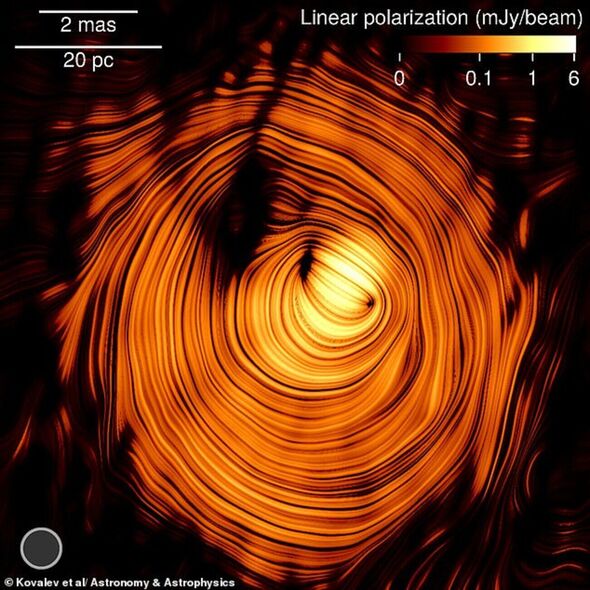Science
Scientists Uncover Blazar Resembling ‘Eye of Sauron’ in Deep Space

A remarkable discovery in deep space has left scientists intrigued as they unveil a phenomenon resembling the fictional “Eye of Sauron” from the *Lord of the Rings* series. This discovery, identified as the PKS 1424+240 blazar, is situated billions of light years away and emits a powerful stream of plasma and energy, known as a cosmic jet.
The PKS 1424+240 blazar is classified as a type of galaxy powered by a supermassive black hole. Researchers have been particularly fascinated by this blazar due to its status as one of the brightest yet slowest-moving jets observed. This challenge to existing theories suggests that not only the fastest jets can produce such brightness, prompting scientists to delve deeper into its unique properties.
It took a team of astronomers 15 years to compile a comprehensive image of the blazar’s jet. This achievement was made possible through a meticulous process of stitching together ultra-precise radio observations gathered from the Very Long Baseline Array, which consists of ten radio telescopes located across various sites.
Lead author Yuri Kovalev from the Max Planck Institute for Radio Astronomy expressed the team’s astonishment, stating, “We have never seen anything quite like it – a near perfect toroidal magnetic field with a jet pointing straight at us.”
The alignment of the jet toward Earth significantly amplifies its high-energy radio emissions. Co-author Jack Livingston elaborated on this phenomenon, noting, “This alignment causes a boost in brightness by a factor of 30 or more.” He further explained that the jet appears to be moving slowly, a classic optical illusion caused by projection effects.
The research team’s findings indicate that the structure of the jet is likely spiral or doughnut-shaped, which plays a crucial role in accelerating particles to extreme energies. This discovery not only enhances our understanding of cosmic jets but also raises new questions about the mechanisms behind such extraordinary brightness in deep space.
The detailed study has been published in the journal Astronomy & Astrophysics, contributing valuable insights to the field of astrophysics. As scientists continue to study the intricacies of the PKS 1424+240 blazar, it promises to be a key focus in the ongoing exploration of our universe.
-

 Entertainment2 months ago
Entertainment2 months agoIconic 90s TV Show House Hits Market for £1.1 Million
-

 Lifestyle4 months ago
Lifestyle4 months agoMilk Bank Urges Mothers to Donate for Premature Babies’ Health
-

 Sports3 months ago
Sports3 months agoAlessia Russo Signs Long-Term Deal with Arsenal Ahead of WSL Season
-

 Lifestyle4 months ago
Lifestyle4 months agoShoppers Flock to Discounted Neck Pillow on Amazon for Travel Comfort
-

 Politics4 months ago
Politics4 months agoMuseums Body Critiques EHRC Proposals on Gender Facilities
-

 Business4 months ago
Business4 months agoTrump Visits Europe: Business, Politics, or Leisure?
-

 Lifestyle4 months ago
Lifestyle4 months agoJapanese Teen Sorato Shimizu Breaks U18 100m Record in 10 Seconds
-

 Politics4 months ago
Politics4 months agoCouple Shares Inspiring Love Story Defying Height Stereotypes
-

 World4 months ago
World4 months agoAnglian Water Raises Concerns Over Proposed AI Data Centre
-

 Sports4 months ago
Sports4 months agoBournemouth Dominates Everton with 3-0 Victory in Premier League Summer Series
-

 World4 months ago
World4 months agoWreckage of Missing Russian Passenger Plane Discovered in Flames
-

 Lifestyle4 months ago
Lifestyle4 months agoShoppers Rave About Roman’s £42 Midi Dress, Calling It ‘Elegant’









